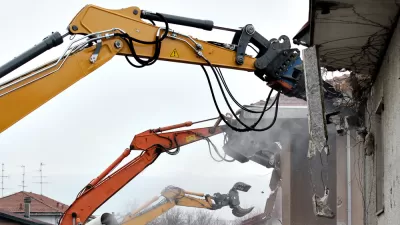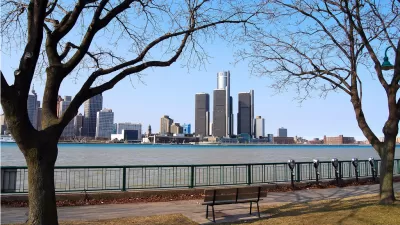Managed decline assumes that struggling cities will continue to struggle indefinitely. Is there a better way to plot neighborhood stabilization?

Jason Segedy, director of planning and urban development in the city of Akron, writes a dissent of the "managed decline" policies that gained traction in Rust Belt cities like Detroit as it struggled with the consequences of a shrinking population.
Segedy acknowledges the argument "that managed decline is a pragmatic approach to present-day economic realities." There is also an argument, adds Segedy, that managed decline is a fatalistic, self-fulfilling prophecy.
Are cities simply hapless victims, subject to the whims of the fates? Or can wise leadership, creativity, and strategic planning create demand to live in a place, and bring about a reversal of fortunes? People who remember Brooklyn in 1977, or East Berlin in 1983, would probably agree that places can change in dramatic and unexpected ways, and that it is sometimes darkest before the dawn.
In fact, argues Segedy, Detroit never actually threw its full bureaucratic weight behind managed decline, and many of its successes now result from embracing the slogan of Mayor Mike Guggan's administration: "Every neighborhood has a future."
To elaborate on the argument against managed decline, Segedy points out a few key areas that offer optimism in Rust Belt cities—and not just Detroit. Opportunities include for new housing, adaptive reuse, and creating incentives for new demand (beyond job creation).
FULL STORY: Housing First: Rejecting Managed Decline in the Rust Belt

Alabama: Trump Terminates Settlements for Black Communities Harmed By Raw Sewage
Trump deemed the landmark civil rights agreement “illegal DEI and environmental justice policy.”

Planetizen Federal Action Tracker
A weekly monitor of how Trump’s orders and actions are impacting planners and planning in America.

Why Should We Subsidize Public Transportation?
Many public transit agencies face financial stress due to rising costs, declining fare revenue, and declining subsidies. Transit advocates must provide a strong business case for increasing public transit funding.

Understanding Road Diets
An explainer from Momentum highlights the advantages of reducing vehicle lanes in favor of more bike, transit, and pedestrian infrastructure.

New California Law Regulates Warehouse Pollution
A new law tightens building and emissions regulations for large distribution warehouses to mitigate air pollution and traffic in surrounding communities.

Phoenix Announces Opening Date for Light Rail Extension
The South Central extension will connect South Phoenix to downtown and other major hubs starting on June 7.
Urban Design for Planners 1: Software Tools
This six-course series explores essential urban design concepts using open source software and equips planners with the tools they need to participate fully in the urban design process.
Planning for Universal Design
Learn the tools for implementing Universal Design in planning regulations.
Caltrans
Smith Gee Studio
Institute for Housing and Urban Development Studies (IHS)
City of Grandview
Harvard GSD Executive Education
Toledo-Lucas County Plan Commissions
Salt Lake City
NYU Wagner Graduate School of Public Service




























